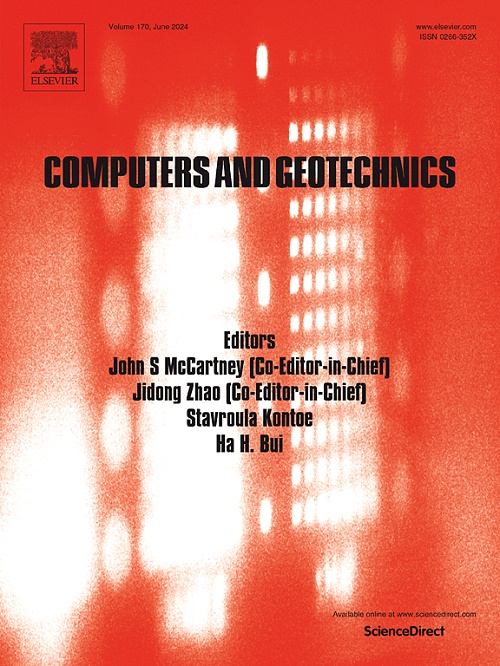Influence of soil crack on large-deformation consolidation of dredged clay under vacuum preloading: A numerical solution
IF 5.3
1区 工程技术
Q1 COMPUTER SCIENCE, INTERDISCIPLINARY APPLICATIONS
引用次数: 0
Abstract
The presence of cracks in dredged clay can influence its consolidation behavior under vacuum preloading. Existing large-strain consolidation models do not consider crack effects. This study proposes a new large-strain consolidation model considering cracks (LSCC) that, for the first time, incorporates the influence of cracks on the permeability and vacuum transmission characteristics of dredged clay. The LSCC model can accurately calculate the consolidation behavior of cracked dredged clay under vacuum preloading. The model divides the soil around the prefabricated vertical drain (PVD) into a cracked area and an undisturbed area. Finite difference methods are employed to solve the model numerically. Validation against a physical model test demonstrates the effectiveness of the proposed approach. Parametric studies investigate the impact of crack formation time and the reduction in permeability due to crack closure under vacuum. Results indicate that cracks accelerate consolidation in the early stages but do not affect the final settlement if sufficient time is allowed. This work provides new insights into the consolidation mechanisms of dredged clay with cracks and offers a practical numerical model for vacuum preloading design.
土裂缝对真空预压下疏浚粘土大变形固结影响的数值解
疏浚粘土中裂纹的存在会影响其在真空预压下的固结行为。现有的大应变固结模型没有考虑裂纹效应。本文提出了一种考虑裂缝的大应变固结模型(LSCC),该模型首次考虑了裂缝对疏浚粘土渗透性和真空传递特性的影响。LSCC模型能较准确地计算真空预压下破碎疏浚粘土的固结行为。该模型将预制垂直排水管(PVD)周围的土体划分为裂缝区和原状区。采用有限差分法对模型进行数值求解。对物理模型测试的验证证明了所提出方法的有效性。参数化研究考察了真空条件下裂纹形成时间和裂纹闭合导致的渗透率降低的影响。结果表明,裂缝在初期会加速固结,但如果时间足够,则不会影响最终沉降。本研究为带裂缝的疏浚粘土固结机理提供了新的认识,并为真空预压设计提供了实用的数值模型。
本文章由计算机程序翻译,如有差异,请以英文原文为准。
求助全文
约1分钟内获得全文
求助全文
来源期刊

Computers and Geotechnics
地学-地球科学综合
CiteScore
9.10
自引率
15.10%
发文量
438
审稿时长
45 days
期刊介绍:
The use of computers is firmly established in geotechnical engineering and continues to grow rapidly in both engineering practice and academe. The development of advanced numerical techniques and constitutive modeling, in conjunction with rapid developments in computer hardware, enables problems to be tackled that were unthinkable even a few years ago. Computers and Geotechnics provides an up-to-date reference for engineers and researchers engaged in computer aided analysis and research in geotechnical engineering. The journal is intended for an expeditious dissemination of advanced computer applications across a broad range of geotechnical topics. Contributions on advances in numerical algorithms, computer implementation of new constitutive models and probabilistic methods are especially encouraged.
 求助内容:
求助内容: 应助结果提醒方式:
应助结果提醒方式:


